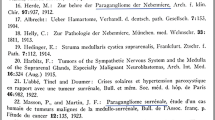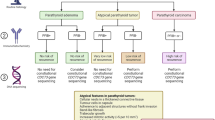Abstract
Neuroblastoma is the most common extra-cranial solid tumor of infancy and childhood, and majority of patients die from the metastatic disease. Orthotopic xenograft mouse models are valuable tools for improving our understanding and control of neuroblastoma metastasis, because they readily represent genetic diversity and allow spontaneous metastasis. Intra-adrenal injection is commonly used for establishing the orthotopic animal models since human neuroblastoma frequently originates in the adrenal gland. However, it is unclear whether the metastatic potential of neuroblastoma can be reliably determined in adrenally-injected mice because their gland size is so small. In this study, we developed and characterized a fluorescent orthotopic xenograft animal model of NB69-derived human neuroblastoma. By comparing animals receiving adrenal injection and adrenal overlay, with the latter mimicking injection spillover, we found that the metastatic potential of neuroblastoma can be reliably determined in animal lungs. Furthermore, the lung metastasis can be genetically modulated in these animals. The results also show that the expression of Renillagreen fluorescent protein (GFP) was exceptionally stable in NB69 cells, allowing rapid and sensitive detection of lung metastases at the macroscopic level. Additional features of our model include 100 tumor take, a 1-week tumor latency, resemblance to tumor behaviors in neuroblastoma patients, and the ability to monitor the expression of a gene of interest with GFP. This animal model of human neuroblastoma will be useful for studying genes involved in the metastatic process and for evaluating anti-metastasis agents in pre-clinical trials.
Similar content being viewed by others
References
Brodeur GM, Sawada T, Tsuchida Y et al. Neuroblastoma. Amsterdam: Elsevier Science 2000.
Brodeur GM, Seeger RC, Schwab M et al. Ampli cation of N-myc in untreated human neuroblastomas correlates withadvanced disease stage. Science 1984; 224: 1121–4.
Caron H, van Sluis P, de Kraker J et al. Allelic loss of chromo-some 1p as a predictor of unfavorable outcome in patients withneuroblastoma. N Engl J Med 1996; 334: 225–30.
Bown N, Cotterill S, Lastowska M et al. Gain of chromosomearm 17q and adverse outcome in patients with neuroblastoma. N Engl J Med 1999; 340: 1954–61.
Brodeur GM. Neuroblastoma: Biological insights into a clinicalenigma. Nat Rev Cancer 2003; 3: 203–16.
Backer JM, Mendola CE, Kovesdi I et al. Chromosomal locali-zation and nucleoside diphosphate kinase activity of humanmetastasis-suppressor genes NM23-1 and NM23-2. Oncogene1993; 8: 497–502.
Leone A, Seeger RC, Hong CM et al. Evidence for nm23 RNAoverexpression, DNA amplification and mutation in aggressivechildhood neuroblastomas. Oncogene 1993; 8: 855–65.
Takeda O, Handa M, Uehara T et al. An increased NM23H1copy number may be a poor prognostic factor independent ofLOH on 1p in neuroblastomas. Br J Cancer 1996; 74: 1620–6.
Keim D, Hailat N, Melhem R et al. Proliferation-relatedexpression of p19/nm23 nucleoside diphosphate kinase. J ClinInvest 1992; 89: 919–24.
Gilles AM, Presecan E, Vonica A et al. Nucleoside diphosphatekinase from human erythrocytes. Structural characterization of the two polypeptide chains responsible for heterogeneity of the hexameric enzyme. J Biol Chem 1991; 266: 8784–9.
Steeg PS, Bevilacqua G, Kopper L et al. Evidence for a novelgene associated with low tumor metastatic potential. J NatlCancer Inst 1988; 80: 200–4.
Parks Jr RE, Agarwal RP. Nucleosdie diphosphokinase. In Boyer PD(ed): The Enzymes. New York: Acadmic Press 1973.
Chang CL, Zhu XX, Thoraval DH et al. Nm23-H1 mutation inneuroblastoma. Nature 1994; 370: 335–6.
Almgren MA, Henriksson KC, Fujimoto J et al. Nucleosidediphosphate kinase A/nm23-H1 promotes metastasis of NB69-derived human neuroblastoma. Mol Cancer Res 2004; 2: 387–94.
Bogenmann E. A metastatic neuroblastoma model in SCIDmice. Int J Cancer 1996; 67: 379–85.
Thompson J, Guichard SM, Cheshire PJ et al. Development, characterization and therapy of a disseminated model of child-hood neuroblastoma in SCID mice. Cancer Chemother Pharmacol 2001; 47: 211–21.
Culp LA, Lin W, Kleinman NR et al. Earliest steps in primarytumor formation and micrometastasis resolved with histochemi-cal markers of gene-tagged tumor cells. J Histochem Cytochem1998; 46: 557–68.
Fowler CL, Zimmer CC, Ruktanouchai D et al. Two newhuman neuroblastoma cell lines exhibiting tumorigenesis andmetastasis in the nude mouse model. Anticancer Res 1998; 18: 1393–8.
Flickinger KS, Judware R, Lechner R et al. Integrin expressionin human neuroblastoma cells with or without N-myc amplifica-tion and in ectopic/orthotopic nude mouse tumors. Exp CellRes 1994; 213: 156–63.
Judware R, Lechner R, Culp LA. Inverse expressions of theN-myconcogene and b integrin in human neuroblastoma: Relationships to disease progression in a nude mouse modelsystem. Clin Exp Metast 1995; 13: 123–33.
Khanna C, Jaboin JJ, Drakos E et al. Biologically relevantorthotopic neuroblastoma xenograft models: Primary adrenaltumor growth and spontaneous distant metastasis. In Vivo2002; 16: 77–85.
Feder MK, Gilbert F. Clonal evolution in a human neuroblas-toma. J Natl Cancer Inst 1983; 70: 1051–6.
Zaizen Y, Taniguchi S, Suita S. The role of cellular motility in theinvasion of human neuroblastoma cells with or without N-mycampli cation and expression. J Pediatr Surg 1998; 33: 1765–70.
Tsien RY. The green. ourescent protein. Annu Rev Biochem1998; 67: 509–44.
Hoffman RM. Green fluorescent protein imaging of tumourgrowth, metastasis, and angiogenesis in mouse models. Lancet 2002; 3: 546–56.
Chang CL, Strahler JR, Thoraval DH et al. A nucleosidediphosphate kinase A (nm23-H1) serine 120–>glycine substi-tution in advanced stage neuroblastoma affects enzyme stabil-ity and alters protein–protein interaction. Oncogene 1996; 12: 659–67.
Mueller BM, Reisfeld RA. Potential of the scid mouse as a hostfor human tumors. Cancer Metast Rev 1991; 10: 193–200.
Wada RK, Seeger RC, Brodeur GM et al. Human neuroblas-toma cell lines that express N-myc without gene amplification. Cancer 1993; 72: 3346–54.
Seeger R, Reynolds C. Neoplasms in children: Neuroblastoma. In Holland JF, Frie E, Bast RC, Kufe DW, Morton DL, Weichselbaum RR (eds): Cancer Medicine. Philadelphia: Leaand Febiger 1993.
Kauffman EC, Robinson VL, Stadler WM et al. Metastasissuppression: The evolving role of metastasis suppressor genesfor regulating cancer cell growth at the secondary site. J Urol2003; 169: 1122–33.
Author information
Authors and Affiliations
Rights and permissions
About this article
Cite this article
Henriksson, K.C., Almgren, M.A.E., Thurlow, R. et al. A Fluorescent Orthotopic Mouse Model for Reliable Measurement and Genetic Modulation of Human Neuroblastoma Metastasis. Clin Exp Metastasis 21, 563–570 (2004). https://doi.org/10.1007/s10585-004-4091-5
Issue Date:
DOI: https://doi.org/10.1007/s10585-004-4091-5




